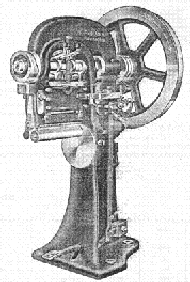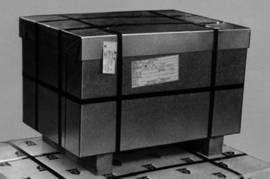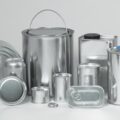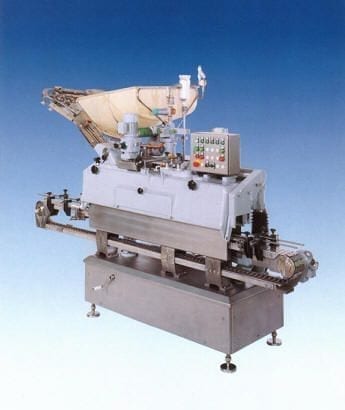INDEX
INDEX
1.- TINPLATE: THE GREAT FORERUNNER
2.- BARRETTES
3.- NICOLAS APPERT
4.- FIRST TINPLATE PACKS
5.- START-UP OF CONTAINER PRODUCTION
1.- TINPLATE: THE GREAT FORERUNNER
If tinplate had not existed, Nicolas Appert’s discoveries on food preservation would hardly have found widespread practical application in the industrialized world of the mid-19th and early 20th centuries. But it was already there ready to join its development to that of the metal container.
Primitive man knew and used tin before iron, the reason may be the lower temperatures that tin needs to melt, which made it easier to obtain. Tin-plated objects are known to be thousands of years old before Christ and the Bible mentions this metal. In the ancient world, iron objects tinned by immersion were considered ornaments and jewelry.
The origins of tinplate date back to the late Middle Ages. There is evidence that in 1240 in Bohemia (Germany) it was already being used to make utensils, which were highly valued for their anti-corrosive properties. But it was not until the 14th century that the evolution of the product began, until it reached the form in which it is known today. In this century, real tinplate was manufactured by dipping iron plates in molten tin.
In the Dresden region and in the 17th century, an important industry based on tinning developed, mainly for export. Among the countries receiving this tinplate was England, which curiously was where the tin was obtained.
Its industrial manufacture began in England (South Wales) in the early 18th century. At that time, the main contributions were mechanical steel rolling and pickling. Progressively this technology spread throughout Europe and the New World. The manufacturing process consisted of immersing steel sheets in molten tin baths and was called “coke” or “hot dip” tinplate. This technique was improved by the German M. Schlöter at the beginning of the 20th century. He devised the deposition of tin on steel using electrolytic baths. This invention soon gave rise to experimental electrolytic tinplating plants in Germany and England, although it was not developed industrially until 1943, when the first electrolytic tinplate plant began operating in the United States.
The new process brought many advantages: precise control of the quantity of tin deposited, improved surface finish, possibility of manufacturing tinplate adapted to the end use, cost reduction, etc.
Then, from the “fifties” until today, this industry has not stopped innovating: continuous casting lines, continuous annealing, “double reduced” tinplate, TFS (tin-free steel), LTS (low-coated steel) etc.etc. These are the milestones that have allowed the evolution of the metal packaging industry to the current situation.
Other raw materials such as aluminum, copper… should be mentioned separately: Aluminum, copper… but it would be making this story too long.
2.- BARRETTES
Since the most remote prehistoric times, man has been well aware of the impossibility of preserving fresh food for a long time and in good conditions. The Paleolithic hunter had to binge on meat if he managed to catch a good piece, because a few days after hunting it was impossible to ingest it. Also in the Neolithic period, when man became sedentary and learned to cultivate the land, he found that cereals were the foods that provided the highest yield, among other things because of their ease of preservation, on the contrary, most fresh fruits hardly kept well for some time.
It is possible that his experience was teaching him that the presence of liquids in food (blood, juices, etc.) was apparently the decisive factor in shortening his life, as cereals and edible seeds showed him. He soon learned to dry fruits (grapes, dates…) and to dry and salt meats and fish (jerky, jerky…).
All cultures developed artisanal techniques to maintain some primary foods for a certain period of time. The basic elements used for this purpose were the combination of the right climate (temperature and humidity) and salt. It was in the eastern Mediterranean, the origin of so many of man’s cultural advances, where the first steps in food preservation have been detected. If you visit the British Museum in London, you can see original small sculptural compositions made of wood representing factories, with five or six people and the corresponding utensils, in which they are making bread, beer, drying fish in the sun or preparing salted fish, and which are dated 2500 years BC.
Classic amphorae
Also, they soon learned to store certain liquids, mainly wine and beverages obtained by distillation or fermentation, which contain alcohol in their composition. The development of pottery was a decisive factor in this, providing the technique for the manufacture of ceramic pieces. Properly sealed vessels were the essential utensils to allow their preservation.
Another option that man used early on was cold as a conservative element. It is well known that the Incas, three thousand years before Christ, used freeze-drying to preserve potatoes, which they spread on high peaks, to expose them to the sun during the day and to the freezing cold during the night, preventing the germination of sprouts on the tubers and facilitating subsequent rehydration. This is how they made the “chuño”, without knowing that they were using a rudimentary freeze-drying operation.
Today it is still possible to see in some villages, close to high mountains, the “neveros”, wells dug in the ground to store snow, which made it possible to cool drinks and food, not only as an element to make them more pleasant, but also to keep them longer. Emperor Charles V, from his retreat in Yuste (Extremadura), so far from the coast – taking into account the means of transport available at that time -, could continue to enjoy his fondness for good food, consuming seafood and fresh fish, for which they made use of snow as a means of maintenance.
Throughout the history of mankind, advances have been added up to the present day. The Ancient and Middle Ages already brought good advances to improve food preservation. Thus, the Romans introduced brine and vinegar as preservatives and invented pickling. Sodium chloride and acetic acid were the first preservative food additives of mankind, in addition to the benzoic and sorbic acids found in some spices, such as cinnamon and cloves, which explain Marco Polo’s travels in search of them.
Medieval Europe added smoking and with it, another preservative additive, formic aldehyde, present in wood smoke. He also extended pig breeding and created an incipient charcuterie and sausage industry, and commercialized salted herring, which was transported in wooden barrels. In the early Middle Ages, Northern Europe, which had been producing beer in the home in an artisanal manner, largely abandoned this custom in order to create the first industrial breweries, and in this context, the standard varieties of lager and stout began to be produced industrially for the first time around the year 1400.
Modern Europe implemented herring and salmon smoking on a large scale, as well as the salting of cod. It markets products such as coffee and cocoa, which it imports from America, and manufactures chocolate. It consumes large quantities of sugar, whose preservative properties it knows, to produce sweets, jams and marmalades. Whale fishing is developed to obtain blubber and meat, as well as other products.
In 1764, metallic boxes began to be used in the United Kingdom to contain tobacco, which was “sniffed” by distinguished Englishmen. Perhaps they can be considered the first packaging of the modern era to contain products.
In the Europe of the Modern Age, the scientific rationalism that was to flourish in the 19th century and that was to have a decisive influence on technological advances took root, but food production continued to concern a large majority of the population, which was rural and agricultural, or maintained rural habits.
3.- NICOLAS APPERT
The metal container manufacturing industry has always been linked to the packaging industry. Any new development in one has influenced the other, so their stories are linked, especially in the beginning. The former has also influenced the growth of other industries, such as steel, tin, equipment, transportation. etc.
Although the packaging of easily decomposable food products was already practiced before the introduction of metal containers, it was not until these came onto the scene that the canning sector developed strongly, evolving towards the methods and technologies we know today.
Developments began in 1765, when Spallanzani in Italy succeeded in preserving food by heating hermetically sealed containers containing various products. This discovery was not followed up; we had to wait until 1795. In this year, the Convention (the new form of state in France) had just put a stop to the “Terror”, sending Robespierre to the guillotine and was engaged in wars with half of Europe (Holland, Belgium, Italy…). It organized a competition, offering 12,000 francs to the person who could provide a process capable of keeping perishable foodstuffs well preserved. The supply needs of his armies (Napoleon was already in command of the Italian army) would lead to an important discovery. Once again, the disastrous wars would be the generators of great technical improvements for mankind.
Nicolas Appert
Nicolas Appert, a pastry chef from Paris, entered the competition and won, being awarded the prize in 1809. Appert’s method consisted of placing meat, fruit, vegetables and fresh or cooked fish in hermetically sealed bottles, immersing them in boiling water for a certain period of time.
Its success was due to the use of three factors: a proper preparation of the food, the availability of an airtight container and finally, the heating of the whole during the right time and at the right temperature. Appert was a methodical person and kept data on the times, temperatures and procedures of the different products he worked with and later published a book on the subject. The factors used for system control are still valid today to ensure a good packaging operation. Food preservation as we now know it was underway.
4.- FIRST TINPLATE PACKS
In 1810, Peter Durand in George III’s England patented the idea of using tin containers to develop Nicolas Appert’s process. It had many advantages: easy heat conduction, light weight, mechanical resistance …. A year later – 1811 – the first commercial packing operation was registered in the same country, using tinplate containers for meat and vegetables, destined for the English Admiralty. Bryan Donkin and John Jall were the pioneers who set up the first canning workshop – in Bermondsey – for this destination. By 1818 the Royal Navy was consuming 24,000 containers annually. It took a few years – until 1830 – for the first canned foods to appear in English stores on a regular basis.
The first commercial uses were to contain cookies and cookies, initially made of bare – undecorated – tinplate. It took more than thirty years – specifically in 1866 – before the first decorated containers were introduced on the market.
Vintage can
The metal container was introduced in North America in 1817 as a means of food preservation. It was the Englishman William Underwood who around this time established the first cannery in New Orleans. However, the tin can enjoyed a rather discreet development until 1861, when the twenty-three northern States of the Union fought with the eleven southern States of the Confederacy, when the great usefulness of this system of conservation became evident.
It is curious that in the early days of metal containers, no provision was made for how to open them. Thus, in 1812, British soldiers opened their cans with bayonets and knives, even with a rifle shot if they failed.
Containers of this type, with a capacity of 4 pounds of food, (soups, roast beef, carrots and fish) were used by the British explorer Sir William Perry, on his excursion to the North Pole in 1824. Some of them were found in 1938, 114 years later, and their contents were still edible. It is surprising to read on them: “Cut around the top with a chisel and hammer”, because the can opener had not yet been invented. This has a simple explanation: the first tin cans were large and thick-walled. Sometimes they weighed more than the food they contained. The tin of meat used by Sir William Parry weighed, when empty, about half a kilo. It was only when thinner steel containers with a rim around the top became widespread – in the late 1850s – that the can opener was able to present itself as a relatively simple instrument. Sir W. Perry’s case and many others of prolonged storage of canned food have demonstrated the practicality of metal containers.
Packaging was originally an agricultural industry. The first packers were also container makers, making containers during the winter and filling them during the harvesting season. As the knowledge of canning techniques spread, filling workshops and factories sprang up in Europe and America, and attempts were made to can almost everything that was edible.
In 1852, R. C. Appert – nephew of Nicolas Appert – introduced the primitive open autoclaves in canning processing. One of the most important products to be packaged was condensed milk. There was an important need for this product, especially where fresh milk was not available. Canning, which began in 1856 under a patent by Gail Borden in North America, helped to reduce the infant mortality rate, which was very high at the time. Each company, on its own, tried to improve the processes (temperature-time conditions) and these were kept very secret, as they implied important commercial advantages. At that time, the figure of the master canner became very important and was the key person in the business. Basically, this process consisted of placing the containers, conveniently filled and closed, in a “bain-marie” (open boiling water bath at 100 degrees Celsius) for a certain period of time. It had serious limitations, since with low-acid foods (meat and fish), certain bacteria could not be killed at this temperature.
In 1860, Louis Pasteur in France proved that at higher temperatures, it was possible to destroy spoilage bacteria in food, thus reducing processing times. This led Isaac Solomon in the U.S. in 1861 to add calcium chloride to the process water, which made it possible to reach up to 115 ºC. in open bath. This caused certain problems such as: increase of burst containers as the internal pressure increased with temperature (with the consequent danger in the area); uncontrolled parameters during the process, since as the water evaporated, the concentration of chloride increased and consequently the boiling temperature of the bath, etc. Despite these limitations, this technique became widespread among the industries of the time.
A fundamental qualitative leap was the appearance on the market of the “autoclave”. It consisted of a container that was hermetically sealed during the process. Its great contribution was to increase the pressure and temperature significantly, but also with the possibility of being regulated at will. The pressure inside the container and the pressure outside the container were better balanced. The first autoclaves were developed by A.K. Shriver of Baltimore (USA) in 1874. This country was living a period of peace and development, after the end of the Civil War between the North and the South under the presidency of General Grant, hero of the North.
Gradually, many other problems had to be solved until the technique of food packaging was completely mastered, but the way was already marked and in the following years very rapid progress was made.. With this, a series of goals were achieved, such as:
– Preserving perishable food products
– Packaging in times of abundance.
– Adequately transporting food to distant points
– To dispose of them out of season.
– Facilitating home preparation
– Cost savings
– Ensuring food quality.
5.- START-UP OF CONTAINER PRODUCTION
The beginning of industrial packaging manufacturing was the logical consequence following the first successful attempts to preserve perishable food products, using different types of containers and heat input. The tinplate container, developed by Durand in 1810, proved to be the best solution – among others – as mentioned above.
The main difficulty to overcome was the tightness of the container. To ensure the efficiency of the process, it was necessary to guarantee that air could not enter the interior. This condition was difficult to obtain when containers were made by hand. The tinplate sheets available to make them were coated with a very thick layer of tin and the steel was not always uniform in thickness and hardness. Obtaining hermetically sealed joints with these early materials was truly an art.
Let’s go into the details of how these initial packages were made:
Bodies:
The tinsmiths of the time traced on the metal sheet, the rectangle corresponding to the development of the cylinder that would form the body, as well as the circumferences of the covers and cut them with manual shears. The body templates thus defined were wound around a drum, overlapping their ends by about 6 millimeters. This area was then welded by hand – with the classic soldering iron that we saw the tinsmiths use as children – resulting in a side seam. Later this type of seam was called “overlapped”.
Old rolling machine
Old crimper
In later years the procedure was improved: the body was bent by passing the inserts through a roller system. In 1861, Pellier in France obtained a patent for a machine – a crimping machine – that was capable of preparing the ends to be welded, folding them and forming hooks that, once joined and tightened, were welded on the outside.
As has already been mentioned, initially it was the canners themselves who manufactured their own containers, but little by little can manufacturers began to appear. This was aided by the development of specific machines with a certain degree of complexity. Thus, in 1883 the Norton Brothers Company of Chicago invented a semi-automatic bodymaker, with a built-in side seam welder, reaching a production capacity of 40 bodies/minute. In less than a decade this equipment was improved and was already capable of exceeding 100 bodies/minute. The Norton Brothers firm was created in 1868 in Toledo (Ohio), initially a vegetable cannery, which manufactured its own containers. It grew and specialized in the manufacture of these products, eventually setting up factories dedicated exclusively to this market.
Covers:
To make the lids, tinplate discs were traced and cut larger than the opening at the ends of the body, so that their edges could be bent to form a “skirt”. This was achieved by hammering with a mallet on a support called “shaper”. In order to fill the food container, one of the lids had a hole of about 35 millimeters in the center, through which this operation was carried out. The packer then proceeded to weld over this hole a disc of the same material, which had also been supplied to him by the packer’s manufacturer.
In 1847, Allen Taylor in the U.S.A. developed a press that, with a suitable tool, was capable of making the skirt or flange on the disc. A few years later, this idea was developed in such a way that the cut, the flange and the filling hole were made simultaneously on the lid. This required Henry Evnas to devise the pendulum press.
Body-cover joint:
To attach the flanged cap to the body, the body was placed on a support or mandrel, then the cap was inserted into the end of the body and the assembly was welded by hand. The procedure was cumbersome and slow.
Because of this, their cost was important, so there were attempts to make them reusable, by rebuilding the open end again, lowering its height and placing a new cover on it. This procedure prospered more or less depending on the country and the products to be packaged. The truth is that it was used for more than half a century in certain regions, until sanitary regulations banished it.
In 1859, it was devised to rotate the body-cover assembly at an angle, introducing the area to be welded in a weld pool. This resulted in an output of 1,000 containers per day per person.
Twenty years later, the first machines appeared, which, developing the previous principle, automatically placed the lids on the bodies and then welded the whole assembly (introducing only the area to be closed in a molten bath by rotating the container at an angle, as already indicated). Thus, the solder alloy was only applied to the seal, leaving the lid clean of solder. Some models of machines capable of this operation were the “Howe float” and Meriam’s “Little Joker”.
Packaging welder in a factory in France
These developments led to a significant increase in manufacturing, which in turn triggered labor problems, as many tinsmiths specialized in hand welding became unemployed.
In 1859, (when the United Kingdom had secured world primacy under the reign of Queen Victoria) Delaware in the U.S.A. and in 1869 E.J. Bourgine in England, each patented a model of seamer, which was capable of sealing in mechanical conditions that already foreshadowed what we know today. Its introduction was progressive and by the end of the century, containers with welded closures and a hole in the lid for filling began to decline. Around this time (1858) the first can opener was patented, devised by Ezra Warner in the state of Connecticut, it was a large contraption, with a curved cutting blade, which in no way resembled those in use today, but it was already a specific instrument for this purpose. A little later, in 1866, J. Osterhoudt in New York developed the first container that can be opened with the help of a key crimped on a tongue. This invention would be widely applied in meat canning.
From the beginning of packaging, it became clear that tinplate also had its weaknesses, leading to attack and even perforation, especially in the case of certain more aggressive products. The manufacturers sought help from the chemical industry and in 1868 the first interior coatings began to be used in the United States.
At that time, a series of small companies emerged in North America, which would be the seed, at the beginning of the next century, of a whole series of powerful companies. To name a few, we will cite:E. L. Parker (1851) in Baltimore, Dover Stamping (1857), Somers Bros. (1862) and S.A. Ilsley (1865) both in Brooklyn which would become part of Continental in 1920, Ginna Co. (1874) in New York which would follow suit, Campbell Co. (1880) in Waltham, a painting with a boat from this firm would go down in history, Acme Can (1880) in Philadelphia which in 1936 would become part of Crown. Near the end of the 19th century – in 1892 – William Painter patented the crown cork – the popular caps – as a closure for bottles and founded the Crown Cork & Seal Company in Baltimore, a company that would become a world leader by the end of the next century. And so many others… but to continue listing them would make this narration too dry.
Since the contact between metal and metal, as in the new closures, was not totally hermetic, different materials derived from paper (Regnauld in 1869) or rubber (Marguet in 1875) were used, placed between the flanges of the cover and the body to be closed. At the end of that century, Charles Ams developed the first liquid sealing compound or gasket, which was applied by hand to the caps, but soon after, Julius Brenzinger started a machine for applying this liquid compound, which would be the forerunner of today’s high-speed automatic gumming machines.
From the beginning, the American market opted for a rather simple type of can, with a cylindrical configuration, which it adapted to different uses (vegetables, meats, etc.).
Europe also begins to generate important companies, in Germany and in the year 1861 Erdman Kircheis in the city of Ave/Saxony creates “Kircheis”, a company dedicated at the beginning to manufacture simple equipment to work with sheet metal (cutters, benders…). In 1880 he created a specific department for packaging machinery. Its development is spectacular, being known all over the world. By 1922, more than 1,200 workers were dedicated to the task of manufacturing excellent equipment based on a myriad of patents. After World War II, when it came under Soviet control – East Germany – it was nationalized and took the name VEB Blema. Even so, it continued to produce a very important volume of machines covering the whole range at a good price but of low quality. With the fall of the Berlin Wall, it was privatized again under the name Blema Kircheis.
In continental Europe, as opposed to America, the market in many cases opted for much more varied shapes: cylindrical, pyramidal truncated pyramids, prismatic, oval, etc. The most refined tastes of old Europe, which always puts a touch of distinction even in the most ordinary things, were noticeable.
Thus, especially for the fish and meat markets, non-round containers appeared, such as rectangular, oval, oblong… This made it possible to present a much wider range of them to the fillers, who used it to further identify some foods with their shapes. For example: sardines with the rectangular one, mussels with the oval one, etc. The manufacture of such containers has always been slower, more difficult and more costly than cylindrical containers, resulting in more complex specific equipment.
This type of packaging, as we have said, was widely used in fish canning, especially along the Atlantic coast, from the Scandinavian countries, through the Netherlands, France, Spain and even Portugal. The fishing ports were the origin of this industry and cities such as Douardedez, Le Havre, Nantes, Santoña, Vigo or Oporto saw the beginning of this activity during this period.
In Sweden and Norway, a fish canning industry is consolidating, which demands appropriate equipment. At the end of the century, the Swede Henrik Jorgen Reinert develops a new type of seaming machine that improves the seaming technology and establishes a company for its construction – “Reinert” – which soon becomes established throughout Europe.
Rectangular fish packaging factory in France at the end of the 19th century.
In 1892, Jules-Joseph Carnaud, 52 years old and owner of a Parisian tinsmith’s store, joined forces with the Forgas de Basse-Indre and took over an old metal packaging factory (Saunier-Tessier) located in Chantenay. Thus was born JJ: Carnaud, which gradually consolidated its position as the leading manufacturer in France and one of the largest in the world. It soon set up factories in the Nantes area and in the north of the country.
A few years earlier, Alfred Rangot – nicknamed Pechiney – had also created the company bearing his nickname in France, in 1877. Initially a chemical company, it later expanded into the aluminum and other sectors. It will eventually become the most important company in France. Although in this period it has nothing to do with the world of packaging, but it is worth noting its birth because in the future it will be a key part of it.
At the end of the century, Johann Andreas Schmalbach set up a new packaging company in Braunschwerg (Germany) in 1898, which was to be named after him. It will continue to grow throughout the next century. In 1967 it will merge with Lubeca Werke in Lübech, creating a strong company with the composite name of both companies. Two years later it will be bought by Continental Can, taking the name Continental Europe.
The 19th century was coming to an end, laying the foundations for what would become the metalworking industry in the following century. Other foundations were also being laid in these years: Germany was defining itself as a great industrial power and was beginning to have frictions with the traditional powers of the century that was ending, which had based their strength on colonialism (England and France). War clouds were beginning to appear on the horizon.






















